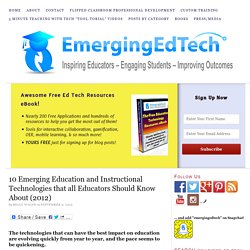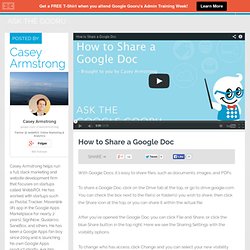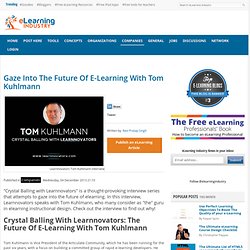

OER. E-Learning platform - Cloud Saas LMS - Learning management system. Assessment. Legal and statutory requiremnts. Flipped classroom. Tools/Sites. Gamification. Books. Best of Lists. Instructional Design. Social Media. Evaluation. Evaluation Toolbox. New tech. 10 Emerging Education and Instructional Technologies that all Educators Should Know About (2012) Naturally, as author of EmergingEdTech, I’m always keeping an eye out for education and instructional technologies that are emerging from the seemingly endless array of tools and concepts that are out there – which applications and ideas are rising to the fore and best positioned to enhance engagement and impact learning?

This year I’ve also been working with constituents at The College of Westchester to develop a Strategic Technology Plan for the next 3 years, so it’s never been more important for me to be aware of those impactful education technologies and concepts that are on the horizon or are already in use and pulling ahead of the pack. Since this listing is more pointedly focused on emerging technologies and looking out over the next few years than the list I published at this time last year, it should not come as a surprise that there are a lot of new entries here (edging out six technologies that remain prevalent and potent, but are more ‘established’ than ’emerging’). E-learning. Quiz Apps. Digital Tools. How to Share a Google Doc. With Google Docs, it’s easy to share files, such as documents, images, and PDFs.

To share a Google Doc, click on the Drive tab at the top, or go to drive.google.com. You can check the box next to the file(s) or folder(s) you wish to share, then click the Share icon at the top, or you can share it within the actual file. After you’ve opened the Google Doc, you can click File and Share, or click the blue Share button in the top right. Here we see the Sharing Settings with the visibility options. To change who has access, click Change and you can select your new visibility settings: Public on the web, Anyone with the link can access, People at your organization can find and access (if you have Google Apps), People at your company who have the link can access (if you have Google Apps), and Private.
You can also invite specific people via email and grant them the ability to edit, comment, or view. MOOC Articles.
Digital Ed. Video resources. Quotes and funny stuff. Teaching and Learning. Accessibility - Research - E-standards for Training. Web accessibility means that people with disabilities can use the Web.

More specifically, web accessibility means that people regardless of disability can perceive, understand, navigate, and interact with the Web. Using web accessibility principles benefits all users because it requires web content and software to be flexible enough to meet different user needs, preferences, and situations. The Australian Government has endorsed the Web Content Accessibility Guidelines (WCAG) version 2.0 for all government websites: Australian Government - Web Guide - Accessibility. This requirement supersedes the previous mandate for compliance with WCAG 1.0. E-standards Research In 2009, E-standards for Training commissioned accessibility expert Roger Hudson to research and evaluate the implications of the introduction of WCAG 2.0 to the vocational education and training (VET) sector: WCAG 2.0 Evaluation for VET Sector (MS Word 2.8MB)
Gaze Into The Future Of E-Learning With Tom Kuhlmann. "Crystal Balling with Learnnovators" is a thought-provoking interview series that attempts to gaze into the future of elearning.

In this interview, Learnnovators speaks with Tom Kuhlmann, who many consider as "the" guru in elearning instructional design. Check out the interview to find out why! Tom Kuhlmann is Vice President of the Articulate Community, which he has been running for the past six years, with a focus on building a committed group of rapid e-learning developers. He also hosts The Rapid E-Learning Blog where he provides practical insights and hands-on tips to develop great e-learning courses.
Tom is passionate about learning and technology, and has over 20 years of experience in the training industry. Many people consider Tom as "the" guru in e-learning instructional design. Learnnovators: What according to you is the future of e-learning? "Crystal Balling with Learnnovators" is a thought-provoking interview series that attempts to gaze into the future of e-learning.
This Week's Best eLearning News and Articles (Issue 1)
Self Directed Learning.